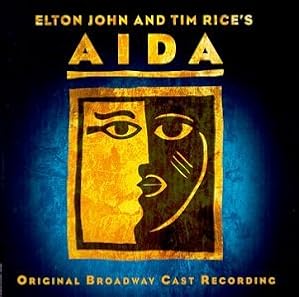 Cover of Aida (2000 Original Broadway Cast)
Cover of Aida (2000 Original Broadway Cast)
The non-profit had differing levels of diversity. As a theatre company, the genders were fairly well represented on both sides. If anything, there were actually more women working in the office than men. Racial diversity, on the other hand, was greatly lacking, both in the office and on stage for the most part.
That season there were two shows that called for race based casting: "Elton John and Tim Rice's Aida" and "Five Guys Named Moe". Though, even in Aida, the Egyptians were (and typically always are) played by white actors. Additional black actors were brought in for Aida to fill out the ensemble because the other two ensemble shows that season had a majority of white actors.
This may not seem like that big of a deal, it's just theatre, right? But how do we promote the shows? Do we specialize any attention to outlets such as The Black Chronicle? As it turns out, my manager decided that she didn't want to specialize any promotions toward any specific community. Stories ran in newspapers including The Oklahoman, The Gazette, and also The Black Chronicle without specializing the message when we sent out the press releases. Whether this across the board equal press release was the right move, I don't know. But the situation did bring up the thoughts of how do we promote shows with a potential special interest to a community without coming across as pandering.
The majority of people I've met working in the arts tend to be white, not just on stage but also in the office and working backstage. This requires diligence on the part of the public relations staff to make sure that everyone is equally represented by the organization.
My job out of college was with a local home builder. The company actually had a pretty racially diverse set of employees. This may have had to do a lot with the fact that the owners belong to a minority and they felt a need for diversity in their business. However with gender diversity, just looking at how many men and women worked for the company did not provide an accurate view of the company as a whole.
Between positions in the field (construction and warranty) and in the office and sales, the amount of jobs were fairly evenly split. But the construction positions were all male. I had heard there had been one female assistant superintendent in the field at one point, but she didn't feel comfortable. The office jobs were predominantly female, to the point that if anyone in the office needed something done that was slightly more physical, it came down to me and a guy in architecture to do it for them. Every time.
A further analysis of management showed that even though women were being hired, there were still more men with positions of management than women. There may have been cultural reasons for this, but I can't really make any assumptions.
Having diversity in the workplace is undeniably useful in being able to think outside of the box as a team. You become more aware of how others will view ads and will read articles when you can see it from a co-worker's point of view.
![Reblog this post [with Zemanta]](http://img.zemanta.com/reblog_e.png?x-id=bc3f8fdd-da00-4f70-a0c1-9f09846dde2c)

You know, I think the issue with diversity will only change beginning with those in power. By that I mean it's the managers, superintendents and so forth that have to take an interest in diversity before anything can be done. As you stated, the business you worked for right out of college had a pretty diverse staff, as well as a minority boss. I would conclude that the boss took an interest in the issue, and took a step forward to make a change, and something like an example. Question, did the business atmosphere seem different in any way at the diverse job than in the other?
ReplyDeleteAs far as the theatre company, was there a minority quota or something? Because I feel like, especially in that business, jobs should be determined more by quality of acting skills rather than race. Or was it that the remaining actors that tried out for the roles happened to all be persons of color?
This is closely related to the topic of my Web site, and I was told to talk with you about the subject and what I could do with the site when this class is over.
The company I worked for out of college was great on the racial diversity front. We had at least three sales people who were native Spanish speakers, as well as some of the builders and office people (especially anyone who had contact with the contract workers). Where the company lacked, in my opinion, was true gender equality. There were female managers, but I don't really feel like they were taken as seriously as the men.
ReplyDeleteThe theatre company did "blind casting" for the ensemble. What that means is that even though it might be a period show (like Hello Dolly) there were still minority actors in the ensemble that wouldn't have necessarily been in those roles during the time period. But with a show like Aida, where the show itself calls for a racially divided cast it is a little bit different. Aida is about the struggles for the Nubians to be free from the Egyptians, with an interracial love triangle at the center of the story.